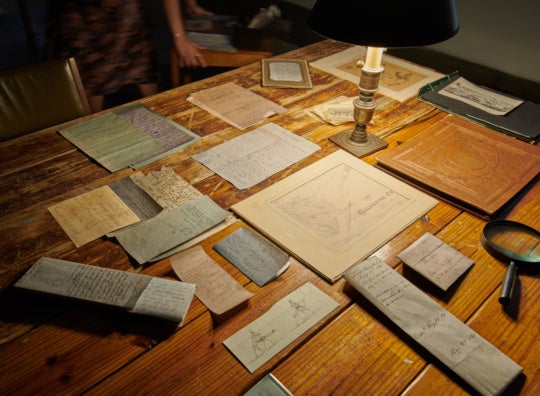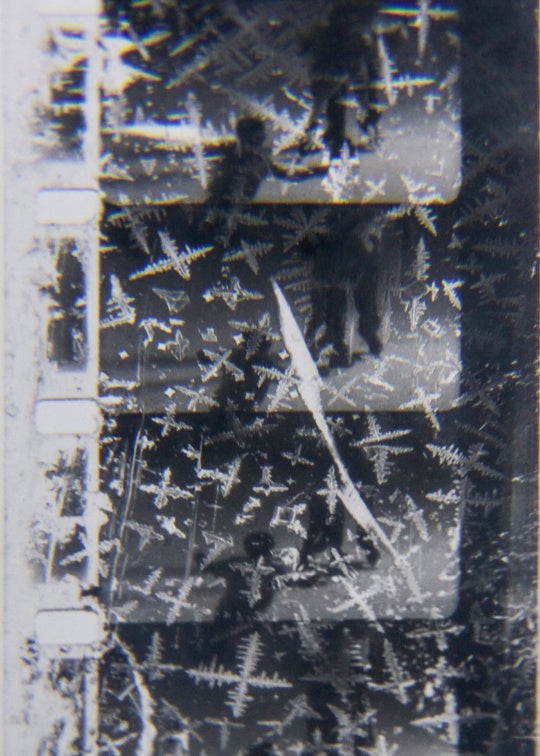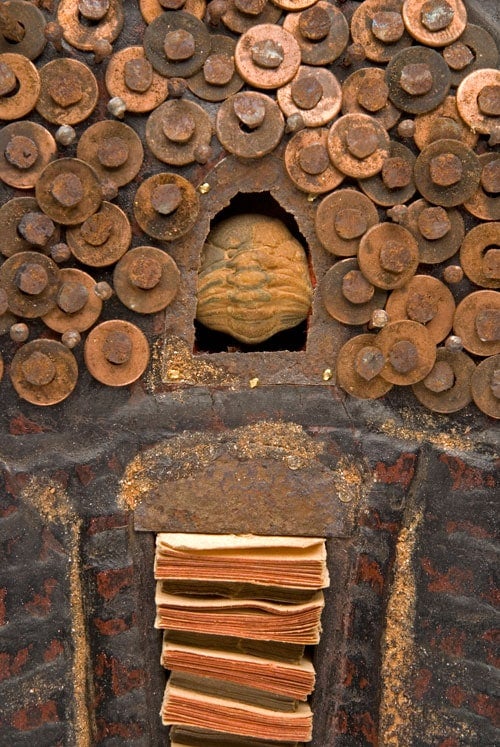
“Call and Response” at Sandler Hudson Gallery showcases the work of two friends, William Downs and Michael Reese, who are mixed media artists with generally divergent visions. In this show, they’ve forged a connection by assigning themselves a theme: communication, specifically the way a single expressive moment can ripple outward in unlimited modulations, and back again.
In a statement accompanying the exhibition, Reese and Downs explain how jazz became a symbol of the type of communication they are exploring in their work. Jazz, that most improvisational of musical forms, is a perfect example of “call and response” communication, where the notes and phrases from one musician can be picked up, re-purposed, and repeated by others in a continual exchange. In the Sandler Hudson show, Reese sends out the call with photographic works that are meant to evoke an echoing, radiating response. Downs, on the other hand, is focused on communication from a completely different direction. His drawings look inward, depicting a call that originates from deep within and the subsequent response that is also mostly internal.
The men are both Southern-born and Atlanta-based. They met at the Atlanta College of Art in 1992, where Reese earned his BFA in photography and Downs in painting and printmaking. Each of Reese’s nine works in “Call and Response” incorporates photography and follows a consistent format: they are framed sheets of 32-by-24-inch watercolor paper brushed with deep black ink, the edges decorated with rounds of colored tissue paper. In the center of each picture is a large circle of glitter; within each sparkly circle is an old photograph. The images are of black men or women from the 1800s, in group or individual portraits, elegantly dressed and posed. In Quatre Femmes (for Nina), the vintage photo shows four young black women in crisp 19th-century blouses and skirts and pretty hats, sitting comfortably beside each other, their faces reflecting a languorous confidence.

In A Hypothetical Kind of Matter, a young black man from the same era poses for his portrait in a neat tie, vest, and overcoat, his left arm raised as if he is making a point during an oration. According to a statement Reese prepared for the show, all the photos—except one, of his grandmother—were among hundreds that he purchased from flea markets or the Library of Congress. Reese clearly chose the nine photographs in these pieces for the specific call, the particular note, that they communicated, and his response to the photos is celebratory. It’s as if his subjects are placed inside a kaleidoscope, surrounded by sparkles and tissue paper bubbles. Looking at them through Reese’s lens, we respond with wonder and nostalgia at these people from a distant time. But because the subjects are black, the response is necessarily tinged with dread and sadness. The composed, elegant, black men and women in the old photos are but one generation or less from slavery, and the generations ahead of them face the perils of Reconstruction, Jim Crow, and the Civil Rights era.
Moving from Reese’s photographic images to Downs’s drawings is like changing the channel from an uplifting documentary to a psychological thriller. His stark, black and white works on paper are full of dark imagery: Transformer is a figure huddled in a fetal position on top of a table, its head seeming to vibrate. Seven other pieces, with titles like Shock Waves, Madness, Madness, Madness and Great Anxiety, are vertiginous depictions of faces that won’t stop moving. Each picture has multiple eyes, noses, and mouths, drawn in vertical or horizontal or circular succession with fascinatingly hysterical precision.

Downs’s Nude Descending Staircase takes its title directly from Marcel Duchamp’s Nu Descendant Un Escalier, and it appears that in some of his drawings Downs could be exploring the mechanics of the moving body as Duchamp was. But instead Downs is recording movement that is entirely unnatural, with heads that vibrate in many directions at once. His descending Nude, with its canine-shaped skull and elongated, flipper-like feet, seems barely human. Downs’s subjects appear to be physically manifesting a raw response to a disturbing emotional call. Similar to the bloated heads in Francis Bacon’s portraits, these are grim studies of the inner human condition.

In an interview in Atlanta-based website Floromancy, Downs describes how he and his former roommate would go to bars and restaurants and draw on napkins. This was spontaneous, improvised “call and response” in action. Downs said, “After eating, drawing and drinking, we would leave a few drawings for the person who was watching or curious about our drawing session. That session became our way of communicating and community.” In “Call and Response,” in their very different ways, Downs and Reese are giving a nod of acknowledgement to this powerful aspect of their art, the wordless conversation.
“Call and Response” is on view at Sandler Hudson Gallery through Sept 9. A conversation between Reese and Downs, moderated by artist Michi Meko, takes place on August 20.
Caroline Stover is a resident of Atlanta working in publishing.




